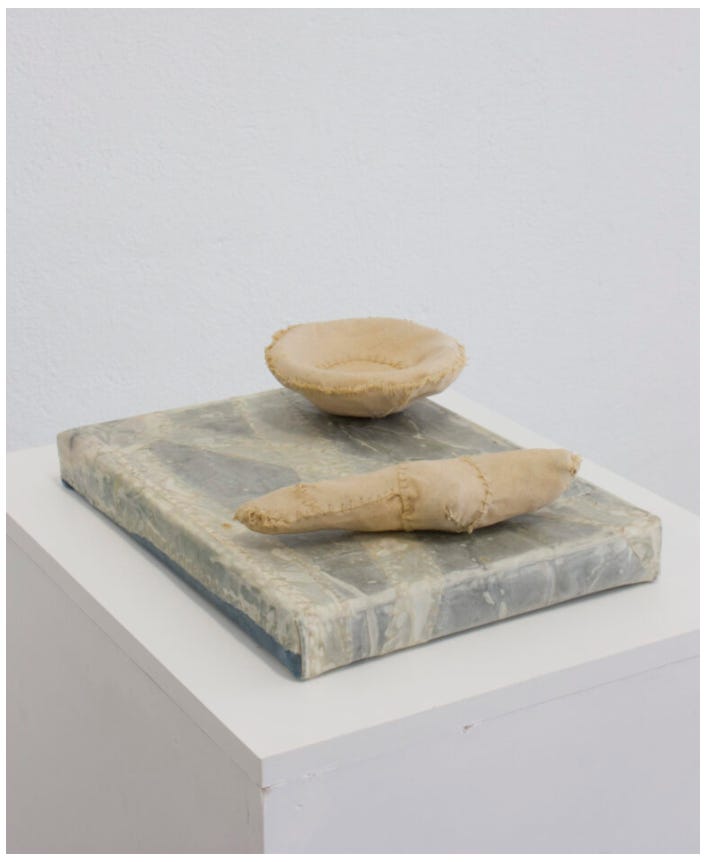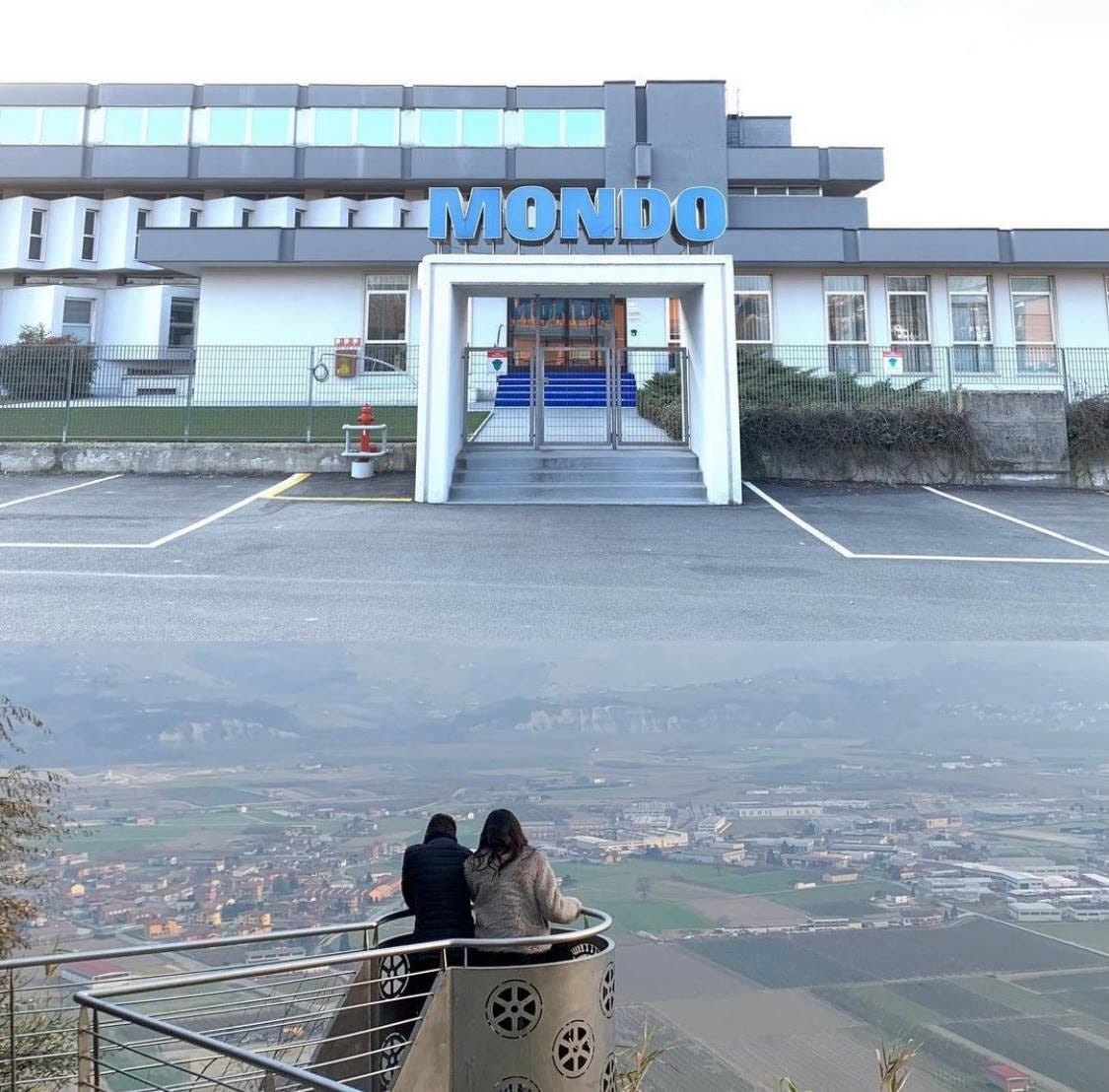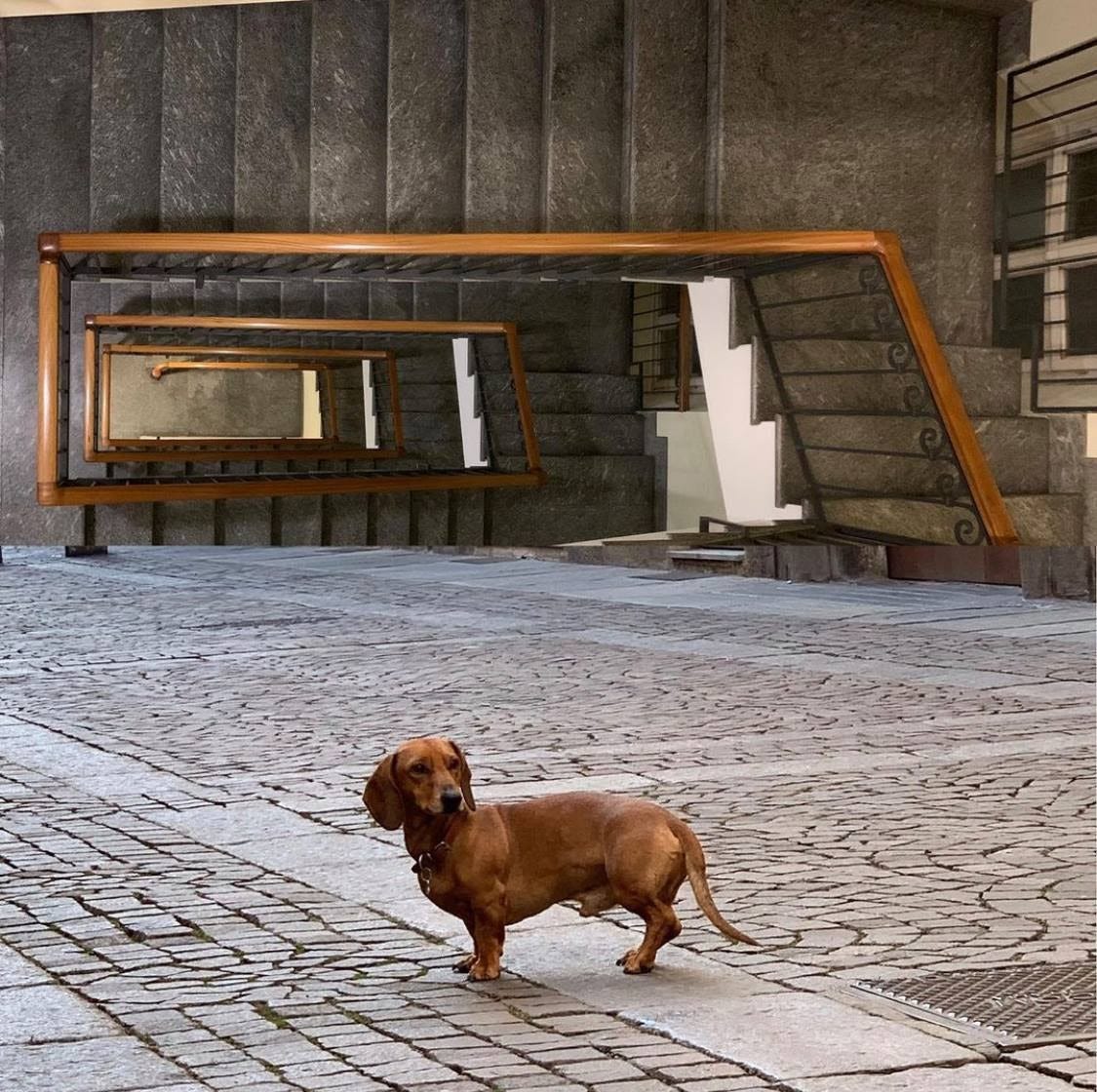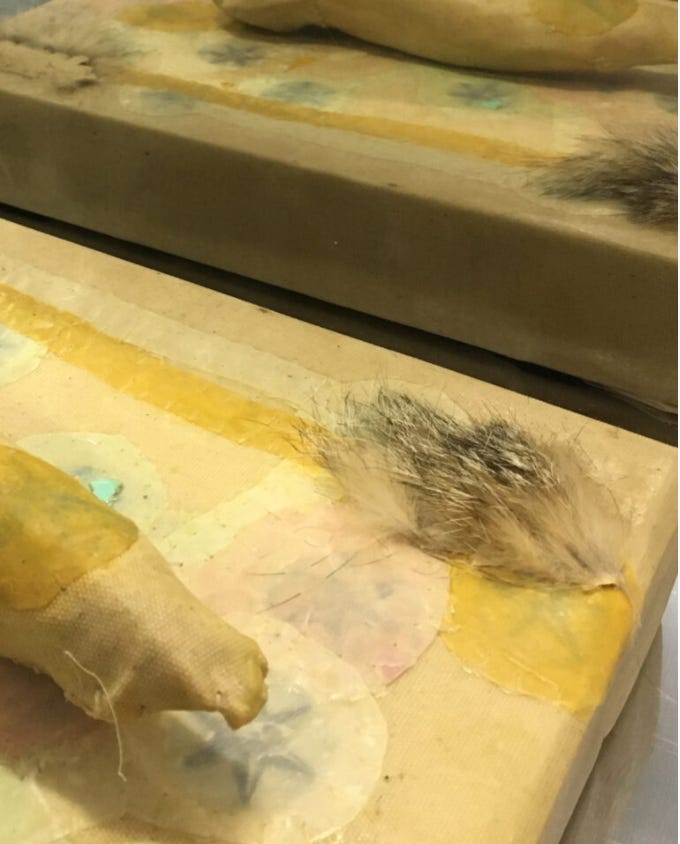Welcome to the eighth Poltern Newsletter!
This week’s issue includes an excerpt of “What Should We Learn from Statues Placed Backwards?” which maps Fred Wilson’s interrogation of U.S. arts institutions’ recurring omission of Native peoples and histories by Anna Ghadar; “mixed, doubles,” a review of the vernacular digital photography of @fontaesi, by Henry Woodland; an interview with artist Virginia Russolo on her recent relocation to Crete, exploration of ancient rites and belief systems, and how these rituals might be activated through the surfaces of painting, by Ariana Kalliga.
If you have any questions or comments, please do reach out to us by responding to this email or writing us at polternmag@gmail.com.
Thank you for being here.
The Poltern Team
Excerpt of “What Should We Learn from Statues Placed Backwards?: Exploring Speech Acts in Fred Wilson’s Mining the Museum”
by Anna Ghadar

A worn-in Klu Klux Klan hood placed in a baby carriage, slave shackles amongst silver tea set, a whipping post posed before four wood-crafted chairs [Figs. 1-3]. These comprise a few of the over one-hundred objects American contemporary conceptual artist Fred Wilson (b. 1954) excavated from the collections of the Maryland Historical Society (MHS) for his seminal 1992 work, Mining the Museum. The aforementioned objects triggered visceral reactions of curiosity, discomfort, and outrage from visitors. The rooms that housed them flanked the exhibition’s second room—‘Gray Room #2’—where Wilson ‘addressed’ his Native heritage.[1] All objects sourced for this space were created by or portrayed Native peoples. The room lambasted the role of the museum in corroborating dominant narratives surrounding Native identities. In Mining, Wilson sought to question the MHS’s ‘failure to represent’ Native and African American histories through examination of the Society’s collections and archives.[2] The exhibition of items Wilson ‘mined’ from the permanent collections spanned the entire third floor of the MHS and was a collaboration between the host institution and The Contemporary Museum in Baltimore, open from April 4, 1992, to February 28, 1993. This essay will explore the ways in which Wilson’s Mining disestablishes the dominant narratives objects from the MHS collections represent to enter into dialogue with the viewer and subsequently implicate the museumgoer in the rupture of hegemonic histories. […]
The MHS was founded in 1844 in downtown Baltimore and is Maryland’s oldest cultural institution. The Society captures a narrow colonial view of the state; however, the population of Baltimore has consistently remained majority non-white. The seventh state carries a rich history as Susquehannock, Nentego (Nanticoke), and Piscataway land as well as a terminus for Black migrants following Emancipation. Wilson identifies as African American, European, West Indian, and Native American, thus his positionality strengthens his ability to speak to these histories. […]

‘Gray Room #2’ prominently featured a wall vinyl of the Chesapeake Bay Waterfowling Region, which depicts the port of Baltimore and its surrounding region. The map portrayed hunting-land, underscoring European settlers’ reliance on cultural exchange with Natives. Here, one can extrapolate a visual illusion to maps of the Native territories on which Maryland is situated. We Shared our Knowledge and our Lives, was a component of the installation that featured a vitrine filled with model canoes and sewn hide sails – physical evidence that Native peoples ‘shared their knowledge’ with European settlers. Europeans learned to sustain themselves in unfamiliar land through cultural exchange. [Art historian and curator, Professor Laura] Peers supports this, stating, ‘European dependence upon and interrelationships with Native people […] typified much of the early contact period’.[3] Both Peers and Wilson point to American institutions’ selective memories regarding Native-European encounters. Such histories are often told through a lens of European dominance with little to no mention of Europeans’ reliance on Natives for guidance and education. Another vitrine display, Collection of Numbers, featured a mass of arrowheads, each with white paint striped across its body, a six-digit inventory number written overtop, emphasizing the colonial impulse to flatten Native identities through taxonomy. Both vitrines recall the museum practice of relegating objects by non-white creators to ethnographic collections. Moreover, this allusion to the binary opposition between European modernity and non-Western primitivity is rooted in colonialism.

A row of five Cigar Store Indians – large, wooden figures that depict archetypal Indians in stereotypical dress, including war bonnets – stood between the viewer and the vitrines. As the name suggests, these statues were common décor in tobacco shops that used ‘Indian’ caricatures in their branding. Cigar Store Indians were commissioned by store owners, who were often of European descent. Wilson labeled each figure ‘portrait of [the shop owner]’, implying they speak more to the ideologies of the commissioners than to the Natives they supposedly portray. Further, he positioned the figures with their backs to the viewer and instead faced them towards other ‘mined’ objects. Facing the back of this figure, the viewer is positioned – literally and symbolically – to follow the ‘Native person’, recreating a position of dependency. There is a duality of asserting agency in the gesture of ‘turning one’s back on’ hegemonic narrative and positioning the museumgoer as following the Native person, further reasserting the position of Native person as leader and viewer as dependent follower. […]

Wilson builds a dialogic exhibition by inviting visitors to respond to the work through surveys upon leaving the exhibit. One visitor wrote of the installation, ‘what should we learn from statues placed backwards except somebody is taking their pretension [too] seriously?’[4] Although meant rhetorically, it is a rich question: what does one ‘learn from’ the subversive positioning of objects in Mining? Theorist Mieke Bal considers knowledge production in the exhibition space in relation to the ‘expository agent’, which she defines as ‘the agency that structures the display, like the narrator in a literary text’.[5] Bal similarly describes the way certain display choices constitute different ‘speech-acts’, which implicate agency and voice in the exhibition.[6] Like Ferguson’s theoretical lens, Bal’s terminology offers a framework through which we can understand the rhetorical significance of Wilson’s display choices. Certainly, there is something to be learned from statues turned backwards, from their transgressive assertion of agency when put in conversation with images of ‘real’ Indians to their disruption of hegemonic narratives elicited as semiotic objects.[7] […]
Just shy of thirty years after the inception of the exhibition, Mining the Museum continues to resonate with questions of art-historical critical analysis that rely on multiplicities of perspectives, histories, and identities. While the work itself was ephemeral, it has had a ripple effect on the history of art and pertinent interdisciplinary studies. This recalls Derrida’s post-structural, semiotic approach to knowledge production which affirms meanings are not ‘fixed’. [8] Rather, ‘they vary according to contexts, which themselves are continually in flux. The meaning of a word in one context is often different in another’.[9] While the hermetic museological practice crystallizes Native identities into a flatted Indian other, Mining restores the context to one in flux, allowing for complex identities and perspectives that exist outside reductive tropes to disrupt the institutional voice. Further, Mining lives on in discussions of voice and authorship as they relate to identity, knowledge production, and structures of power within the exhibition space. While not touched on in exhibition reviews at the time, the double entendre of mining begs ancillary questions. Wilson’s physical and emotional labor of mining through the MHS collections is meaningful. Additionally, ecological implications of Native archeological and historical sites build on the notion of institutional pillaging. How might connotations of excavation and exploitative labor relate to post-colonial and ecocritical studies? Timothy Clark notes that ecocriticism ‘asks fundamental questions about the nature and causes of environmental crises, the ways they are represented in language and culture, or contested or interpreted in literature, in art or daily discourse.’[10] The literal representations of nature, as well as allusions to nature in the work’s title, incite a line of questioning about the ecological implications of colonialism. The notion that meanings are not fixed shatters the concept of a single objective truth, affirming the validity of alternative histories and counter-narratives.
—
Anna Ghadar is currently a Candidate for the MSt in History of Art and Visual Culture at the University of Oxford.
[1] Lisa G. Corrin, ‘Mining the Museum: Artists look at museums, museums look at themselves’, in Mining the Museum: An Installation, ed. Fred Wilson and Lisa G. Corrin (Baltimore: Contemporary in Association with the New Press, New York, 1994), 14. [2] Corrin, ‘Mining’, 8. [3] Laura Peers, Playing Ourselves: Interpreting Native Histories at Historic Reconstructions (Lanham, MD: AltaMira Press, 2007), xxii. [4] Fred Wilson and Lisa G. Corrin, eds., Mining the Museum: An Installation (Baltimore: Contemporary in Association with the New Press, New York, 1994), 64. [5] Mieke Bal, Double Exposures: Subjects of Cultural Analysis (New York: Routledge, 1996), 87–88; 166. [6] Ibid., 87. [7] Notably, the Contemporary curator, Corrin, references Bal in her exhibition catalogue essay for Mining. 15. [8] Laurie Adams, The Methodologies of Art: An Introduction, 2nd ed. (Boulder, CO: Westview Press, 2010), 129. [9] Ibid., 127. [10] Timothy Clark, The Value of Ecocriticism (Cambridge, Cambridge Core, 2019), 5.
@fontaesi — mixed, doubles.
by Henry Woodland
In an essay on Seker Ahmet, John Berger focused on the warped perspectives of Ahmet’s horizons, which often bleed disparate perspectives to disrupt the narrative expectations of a picture. ‘How did he come to paint it in the way he did?’ Berger asks. ‘At one level the question is unanswerable and we shall never know. But it is possible to guess at the depth at which his imagination was working to reconcile two opposed ways of seeing.’
That passage was cut by a competing memory, of another John, from my school. She would take novels and tear individual pages at the inside of the spine from their top to around the middle of the text, then crease the top half and fold it behind the lower. In this origami formation, the reader encountered the top half of a future page which lead into a past one (pick up a book and you will see what I mean: if you fold page 7 in half behind itself, the first few paragraphs you see on the page will be from page 9). John would then read these passages, sometimes out loud to us, raising her frustrated adolescent vandalism to the status of literature, inflecting the mismatched chronology of the new text.
My fascination with John’s practice chimes with Berger’s interest in Ahmet. There’s so much of everything now, and pressed with constant juxtapositions of loose images, we must work towards a synthesis in order to survive. Learning to view both has become a full-time job: a billboard comes up against a canal; a view of a children’s birthday party in the street is cut by a balcony with man smoking; fireworks from afar are bisected by an apartment building, itself half-obscured by the Amazon smile. This is not to mention the dynamic mixing that occurs beyond bisected lines of sight: double-denim, half-silvered mirrors, electronic shopfronts, translucent revolving doors, dogs resembling owners, celebrities passing tradespeople on the street, film stills from sitcoms on a t-shirt in a vlog.
I saw my first @fontanesi photograph on Instagram, about two years ago, in a mess of other images. They trade in the same technique of splicing as John’s cuts: each contains two photographs superposed, probably using Instagram’s own ‘Layout’ app. We receive one thing formed from two, sewn with a borderless horizontal line. This creates a repeated collage with the hinges showing, pressing one form into another.
Sometimes this practice is a formal game, as @fontanesi finds resonances between disparate images. The results are often deft and delicate. In one, (13 June 2021), the green sleeves of a sweater, almost imperceptible, bloom up into a landscape of foliage and sky. In another, (1 March 2020), grey clouds above a couple in a lookout blend into the road in front of an industrial building. The fog melts into the asphalt so naturally that it feels like it must be dynamically merged—but, as always, @fontanesi’s only tool is a single digital incision.
Even where there is less of a visual sensitivity, the images often trade on a semantic point, creating a visual pun: a chandelier hangs above a group of people underneath umbrellas (19 December 2019); a dog in a cobblestone square stands above a pool of mosaic fish as if watching them (6 March 2020); the bottom half of a man’s smiling face is completed with that of a gnome, joined by a crowd of gnomes behind him (6 May 2019).
I like it most when @fontanesi abandons these aims of reconciliation and works in disjunctive visuals. Some of these photos deny continuity of perspective by actively bending lines of sight against one another. A mid-length shot of a dog from across a town square is met with a view that looks straight down the centre of a spiral staircase (20 December 2020). The complete picture forms a 90-degree vault, folding up and over its own point of view. More recently, @fontanesi has been abandoning even this play of perspectives, combining two images with seemingly no connection: a garden path curls under a stack of loose papers (17 May 2021); a rack of fur coats crowds above a single-scull on a river (20 January). Playful! Inexplicable! But not comprehensible.
Met with a world full of contradictory images, @fontanesi either loosely reconciles them or announces that they do not care to. This rhymes with the pastiche of images presented on Instagram itself, which are neither coherent nor consistent nor charted with any continuity. @fontanesi recognises this but also points to its concealment. Even as Instagram endorses shared images, it denies their necessary hybridity, encouraging iconicity and individuality of the user’s shared content even in light of its entry into hyperspace. Even the most formally experimental image is framed and adorned with the status of a ‘whole’. This denies its solubility with the mass of other images with which it comes into contact, preserving a history of binary ways of seeing. @fontaesi’s embodiments recognise their inevitable complicity with completeness and so resign to Instagram’s formal conditions to highlight them. Furthermore, the use of the low-function layout tool points to the futility of self-sufficient photographs, challenging the idea that reality is received in personal impressions.
The act of seeing a single thing inherently converges with other images, whether real or imagined. What is perceived is constantly spliced with other visual planes and articles. @fontanesi’s cut is a slash in a canvas, allowing us a glimpse of what we couldn’t say. When I see Ahmet’s horizons, I see my friend John’s sliced novels, and now a @fontanesi. This, mixed, doubles, and then repeats.
—
Henry Woodland is currently an MSt candidate in English at the University of Oxford.
Interview with artist Virginia Russolo
by Ariana Kalliga
The works of Virginia Russolo (b.1995) invite us to explore ancient rites, belief systems, and rituals, activated through the surfaces of painting. The artist ascribes a ritual significance to the application and order of materials; repetitive action allows for a state of meditative tranquility free from distractions and the expectations of viewership. Animal and plant materials, such as beeswax, propolis, and oils, are reworked, anointed, and massaged, gradually revealing the translucence, hue, and even the scent of the final form. Russolo’s newest series of works, Mappe Altari (Altar Maps), began shortly after her move to Crete. These maps blur the boundaries of the real, the abstract, and the sacred, suggesting connections to dwelling, geological matter, ritual, and animated play. As sculptural cartographies, they stimulate our primordial understanding of touch as a means of navigation, heightened through the uncanny interplay of fur elements and suspended objects.
Russolo grew up in Italy, the United States, Japan, the Netherlands, and the UK. In 2017, she obtained a BFA from The University of Oxford and has since exhibited at gallery T293, Italy; K-Gold Temporary Gallery, Greece; the 7th Thessaloniki Biennale, Greece; The Pitt Rivers Museum of Ethnography, UK; Modern Art Oxford, UK; Tate Modern, UK; and Fondazione Spinola Banna, Italy. This May, Virginia will be participating in the Mediterranea 19 Young Artists Biennale in San Marino.
—
Ariana: Ciao Virginia! We first met this year in Athens after your big move to your studio in Crete. How is life in Crete treating you so far?
Virginia: The move to Crete has been good. I found an amazing studio—the largest I’ve ever had—and in it, I started making the smallest works I’ve ever made. Being here is a dream come true because of the proximity to archeological sites and the access to animal materials. It’s only been a few months but I’ve already noticed I’m using a wider range of materials from sheep and bees in my work.
A: I can’t wait to visit this large studio packed with your tiniest work. Can you tell me about the current body of works you’ve been busy researching and the choice of materials you’ve been exploring?

V: My most recent series is titled Mappe Altari (Altar Maps), it’s still a work in progress so I’m finding things as I go along. I’m putting together research on maps as tools to explore non-physical places and the situation of objects being moved on a surface of symbols, which is similar to that of a board game. These works keep me circling around to the dynamics of ritual, the fetish object, and the proximity of play and the sacred.
The choice of using materials such as fat, propolis, beeswax, lanolin, bee pollen, and animal fur is about protecting the knowledge on the surface of my work. To better understand this dynamic with my paintings and sculptures, I’m looking to the worship of objects. One branch of this research concerns the cult of sacred stones in the Mediterranean, including the baetyls of ancient Minoan Crete. I’ve been looking at the imagery on seals and coins to learn about materials involved in worshipping these stones such as olive oil and wool.

A: How central is topography to your current series Mappe Altari (Altar Maps) and your long-term exploration of ritualized spaces?
V: Using these materials forms an inextricable connection to the land I’m working in. For example, all decisions that concern color are in response to the colour of beeswax, which is never the same and is determined by the flowers that were in season. The materials I use are, to me, archives of information and can act as gateways to get a sense of larger cycles of transformation of matter on earth.
Regarding ritualized spaces, I’ve recently discovered the importance of touch in my process. I’m at the beginning of researching the activation that touch enables when worshipping sacred objects. Some of these objects are stone oracles of the Mediterranean, such as the Omphalos at Delphi and the Bocca della Verita in Rome, but more broadly any surface that has to be touched in order to create a spiritual connection. This is reflected in my recent works which have a smooth finish similar to marble or stones subjected to the touch of worshippers over time. I’m currently exploring this in a large painting for the Mediterranea 19 Young Artists Biennale.
A: I wonder if these Altar Maps draw on any past examples of equally ‘playful’ mapping practices. Have you looked into cultural precursors to these ‘game-board’ like structures?
V: The practical element of Mappe Altari, the tracing of two-dimensional symbols and paths with objects, is crucial for me as they are first of all tools for exploration and information gathering. This aspect of the work guides my research. Part of this research began upon seeing paintings by Ngupulya Pumani at the National Gallery of New South Wales. I was amazed by the ability to map, to condense into an object, part of the colossal legacy of the Dreamtime. I’m also interested in the role Saami Shamanic drums play in facilitating movement through non-physical spaces during ceremonies and their place in the house as tools to seek advice from. I’m also interested in the way they are activated through touch.
Another branch of my research concerns Sankei Mandara, large-scale topographical depictions of sacred sites from late Medieval Japan. These maps functioned on different levels: to encourage a physical pilgrimage to the temples depicted but they also served as a conduit for a non-physical journey by inducing the viewer to project themselves into the map and receive the spiritual benefits of the pilgrimage. These pieces of my research function for me as material evidence of the possibility of traveling through images and condensing legacy into objects.
A: Created through the repetitive application of beeswax, oil, leather, fur, and other natural materials over time, your works naturally undergo a process metamorphosis, containing within them intimate knowledge of your own ritual process. How do you envision this series will change over time?
V: I’m very excited not to know where the work and research will go next! I’m currently making a large painting, a large map, measuring roughly three meters on each side. This scale has allowed me to feel a more bodily connection to the symbols and the materiality of the work. I imagine the intensity of this experience will inform my next pieces.
—
To see more of Virginia’s work, please visit her website.
Ariana Kalliga is a curator and researcher living in Athens, where she curates the nonprofit Space52—which she runs with artist Dionisis Christofilogiannis—and is interested in testing the borders of experimentation and knowledge that spring from artist-run spaces. She is currently curating the exhibition, Never Cross the Same River Twice, alongside French-Togolese independent curator Kisito Assangni with the support of the NEON Organization. Kalliga is a graduate of the University of Oxford History of Art department.
This interview was originally published on the Space52 website—you can read the original text here.
Please follow us on Twitter and Instagram (@poltern_) for updates and share our newsletter with anyone who might be interested.
PS—we’re doing an open call for reviews, features, interviews, and creative writing. If you have work that confronts issues in art history and the visual arts, email us at polternmag@gmail.com. We’d love to feature it 📝








